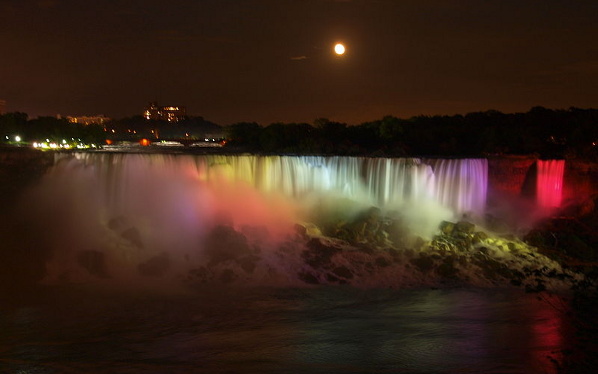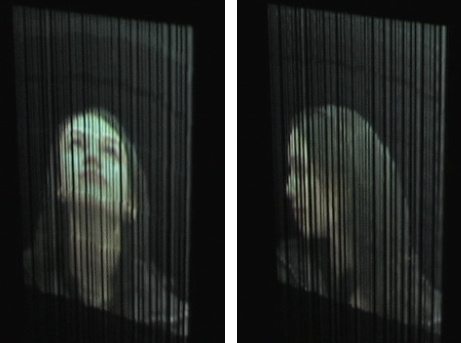Drawing on Water
August 2, 2010
The expression, "drawing water," is quite ancient, and it refers to the act of pulling up a bucket of water from a well. Drawing
on water, however is something new that exists solely as a consequence of modern technology. There are quite a few fountains that are lighted at night, and some are programmed with multicolored lights to give a dynamic light show to passersby. Such light displays in water are facilitated by the
solid-state light sources now available. A water light display on a very grand scale is the light show at
Niagara Falls that's been in operation since the early twentieth century. I saw this light show myself when I was sixteen, as a side trip to my appearance at the
FCC Field Service Bureau in
Buffalo, New York, to take the examination for my
commercial radiotelephone license. The light show was impressive; but, then again, so is the Falls. Niagara Falls was once the
honeymoon destination for the Northeast. Now, it's
Disney World,
Orlando, Florida. They have a light show there, as well. It's a small world, after all.

Niagra Falls Light Show (photo by Ujjwal Kumar).
A wall of water can act as either a front or rear projection screen because the
refractive index of water (
about 1.33) differs from that of air (
about 1.00). According to
rudimentary optics, the reflectance
R at the boundary between media of different refractive indices,
n1 and
n2, is given as
R = [(n1-n2)/(n1+n2)]2
so, the reflectance is about 2%. This is somewhat less than that of window glass (refractive index
about 1.5) which has a reflectance of about 4%.
This calculation assumes a smooth, homogeneous slab of material, which leads to a form of reflection known as
specular reflection. This is the type of reflection we want for a mirror (Latin,
speculum). A wall of water, however, is nothing like that. It's composed of individual reflective elements below the surface, typically the result of air bubbles. The reflection in that case is
diffuse reflection, and much more of the light is reflected. This is put to good use in the water light shows I mentioned above. Niagara falls pumps air bubbles into its water naturally, and separates the water into separate reflecting cascades. Fountain designers know they need to do the same with their water spouts to get the best effect.
Robotics researchers at
Carnegie Mellon University have applied their skills to development of a system, called AquaLux 3D, that projects three-dimensional images in a volume filled with precisely generated water droplets.[1-8] Their research was presented last week at
SIGGRAPH 2010 (
SIGGRAPH is an acronym for the Special Interest Group on Graphics and Interactive Techniques of the
ACM). The precise generation of droplets is essential, as is the rate of droplet generation. The reason for this speed and precision is that the light rays that paint the images in space need to address each droplet independently of the others. What looks to the eye as a solid mass of water is actually interleaving planar arrays of droplets that are timed so that there is enough empty space between any individual droplet and the light source that the light hits particular droplets only. The eye integrates the image over time so it appears continuous.

Photographs of AquaLux 3D Images, from Ref. 1.
In the AquaLux 3D system, planar sheets of water droplets are formed by application of a slight pressure pulse to a water-filled pipe festooned with small stainless steel needles. In the current prototype, three or four such manifolds are used to allow three or four image planes. The manifolds are sequenced so the light source has a clear line of sight to the current row of droplets in any single plane. A camera monitors the droplet position in a feedback loop to enhance accuracy. In simulation of a
progressive-scan rastered cathode ray tube, the drops are generated at up to 60 Hz. The spherical droplets act as small lenses that diffuse the light over a wide angle.
Scientific serendipity is a well known phenomenon, and it was present in the AquaLux 3D project. The CMU team's initial goal was the development of an advanced automobile headlight system for nightime driving in the rain. They intended to shine the light between raindrops. It was a difficult problem, since the raindrop timing was out of their control. It was a quick step from that idea to the AquaLux 3D concept.[7] There are videos of the AquaLux system on YouTube,
here, and
here (low-tech version).
Wonderfalls was a cute television series that premiered on March 12, 2004, and ran for just one season. The main character, a recent college graduate, finds that the only job she can get is as a sales clerk at a Niagara Falls gift shop. That part, at least, has the ring of truth. The rest of the story is that she is coached by talking animal figurines, such as a wax lion and a
mounted fish, to help people in need. I loved the show, which was a sure sign that it would be canceled.
References:
- Katie Falloon, "Images land on layers of droplets to create 3-D display in CMU project," Pittsburgh Post-Gazette (July 28, 2010).
- Smaranda Biliuti, "3D Water Holograms via AquaLux 3D," Softpedia.com (July 7th, 2010).
- Darren Quick, "New 3D display technology projects multi-layered images onto water droplets," Gizmag.com (July 6, 2010).
- Peter Barnum, Srinivasa Narasimhan, and Takeo Kanade, Project Page: AquaLux 3D: A Multi-Layered Display with Water Drops.
- Byron Spice, "Multi-Layered Images Projected Onto Water Droplets With New Carnegie Mellon Display Technology," Carnegie Mellon University Press Release (July 6, 2010).
- Lewis Page, "New 3D displays use falling water drops as 'voxels'," The Register (July 7, 2010).
- Alan Boyle, "3-D pictures writ in water," MSNBC Cosmic Log (July 6, 2010).
- YouTube Video: A Multi-Layered Display with Water Drops; YouTube Video: A Multi-Layered Display with Water Drops (non-technical version).
Permanent Link to this article
Linked Keywords: solid-state light sources; Niagara Falls; FCC; Buffalo, New York; commercial radiotelephone license; honeymoon; Disney World; Orlando, Florida; refractive index; rudimentary optics; specular reflection; diffuse reflection; Robotics; Carnegie Mellon University; SIGGRAPH 2010; SIGGRAPH; ACM; progressive-scan; cathode ray tube; Wonderfalls; mounted fish